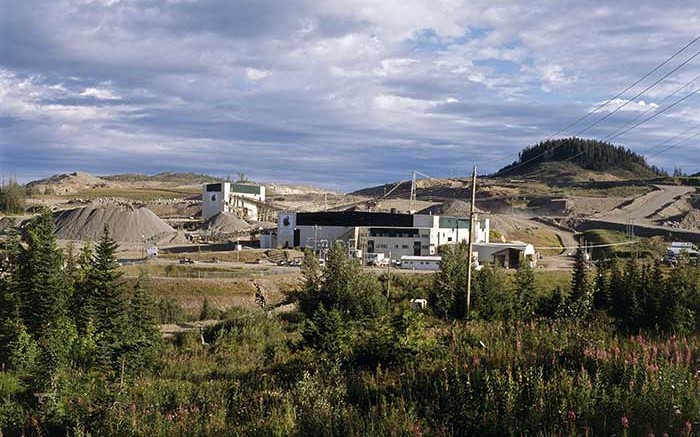VANCOUVER — Imperial Metals (TSX: III; US-OTC: IPMLF) has been given the green light to temporarily resume operations at Mount Polley, 56 km northwest of Williams Lake, B.C., provided the company meets a number of conditions set by the B.C. Ministry of Energy and Mines and the Ministry of Environment.
The open-pit, copper-gold mine has been under care and maintenance since an unprecedented breach occurred along a section of the mine’s tailings dam facility last August.
“It’s a huge milestone for us — we’ve worked hard to get the permit for the restart,” Steve Robertson, vice-president of corporate affairs, tells The Northern Miner during an interview. “Now we can go forward with the confidence of the regulators and community, and move back into production.”
Under the new permit, Imperial can operate the mill at half capacity for one year and process up to 4 million tonnes of ore. The tailings facility will not be used during the operation, and any waste or water will be discharged into the existing Springer pit.
Robertson says the production decision “isn’t a big moneymaker for the company, it’s about bringing stability back into the lives of our workers, who depend on us for an income.”
But he adds that operating at half the rate gives the company enough time to go through the mandated permitting process, and plan for the mine’s longer-term restart.
Included in that process are short-term water management and monitoring plans that are due in the third quarter, around the same time natural water levels in the Springer Pit will reach permitted capacity.
“We have too much water on the mine site, and it needs to be discharged whether the mine restarts or not,” he says. “The bulk of the technical work has been completed for the short-term permit, and we’re examining this thoroughly to make sure we have the best option possible to release that water to the environment.”
The production decision came as a disappointment to the Soda Creek and Williams Lake First Nation Bands, who stated in a recent press release that the B.C. government acted without their consent.
“Proper environmental due diligence has not been followed, and, even with the restrictions imposed, the decision fails to address serious and clear concerns raised by both First Nations … including the continued failure to provide a short-term water discharge plan,” Soda Creek Chief Donna Dixon stated. “There was a commitment last year that a consent-based agreement was necessary to deal with the cleanup and potential reopening.”
But the Minister of Energy and Mines, Bill Bennett, says the decision was “rightly balanced.”
He tells TNM in a telephone interview that “while I understand the worry the First Nation groups are expressing, we did not break any term of a commitment to them. We made sure the groups were fully aware of the progress the company was making on its application to reopen, and we are comfortable that the restricted operations do not place anyone, nor the environment, at any risk. We are allowing this restricted permit so we can get 220 people back to work, and if Imperial cannot provide a short-term water management plan before the Springer pit reaches its acceptable maximum level, then they have to stop.”
Imperial is also required to submit a five-year reclamation and mine plan by the end of September, and follow up with a longer-term water discharge and treatment plan by next June. If the company fails to comply with the permitting schedule or the conditions noted by the two ministries, operations at the mine will be shut down.
Although Robertson says the company is “undecided” about using the tailings facility in the long term, he says that “we probably have the most thoroughly examined design and tailings facility in the world, and we’re well armed with enough information to provide a suitable solution to go forward.”
The company expects it will take a month to get the mine back into production under the new permit, and while in operation it plans to keep restoring Hazeltine creek, and add supporting structures along the tailing embankments.
The company has spent $67 million on remediation work since the dam failed last year, spilling 25 million cubic metres of mine waste and water into the surrounding environment.
An independent expert review panel that investigated the cause of the failure reported early this year that the breach occurred because of an original design flaw that didn’t take into account the strength and location of an underlying layer of clay, called the “upper glaciolacustrine unit.”
According to the report, this layer occurs discontinuously underneath the perimeter embankment, and was “situated at the worst possible place in the dam foundation,” reaching maximum thickness at the site of the failure.
It explains that many of the condemnation holes for the original design plan were too shallow, or the strength of the layer was misinterpreted. The report did not specify if a similar layer was found underneath the facility’s main embankment.
Investigators also found that “failure would have been avoided” if the slope along the perimeter dam was flattened as proposed in its original design, and speculated that emergency actions could have been more effective had there been less water backed up on the dam. Imperial was building a supporting buttress when the breach occurred.
Investigations into the responsibility and liability of the breach are ongoing until September, but information could be kept back from the public if it gets held up in court.


Be the first to comment on "BC government sets mandate for Mount Polley start-up"